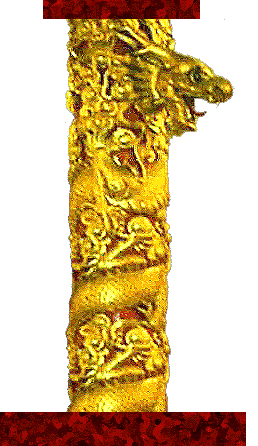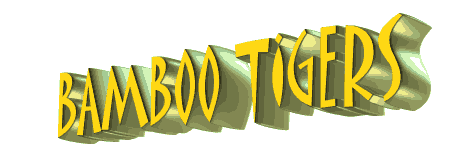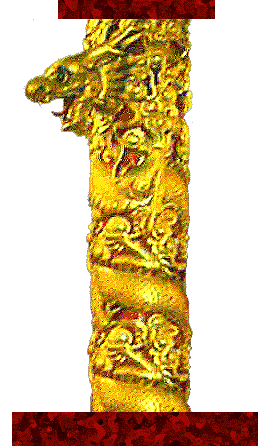| |
Time passed. Chinatown prospered. San Francisco achieved unique status among the great cities of the world and often referred to itself simply as "The City," in the manner of New York. It became, in the words of its own Convention and Visitors Bureau, "everybody's favorite city," and Chinatown was really something to see.
Centered around Grant Avenue, the oldest street in San Francisco, the 40 square blocks of Chinatown include restaurants, curiosity shops, live-fish markets, row tenements climbing steep hills, and narrow lanes duplicating the back streets and alleys of Shanghai and Hong Kong and the hutungs of Beijing. More than a mere ethnic enclave, Chinatown is a totally Chinese world housed within an American city.
Banks, utility offices, shop fronts and even telephone booths are "Orientalized" with pagoda eaves and exquisitely carved pillars. Brilliant tiles, gaily colored or gilded, shine in the California sun, then turn luminous in San Francisco's fabled fog.
Behind this glittering façade, many residents live Chinese, not American, lives.
Chinatown seduces the imagination with visions of romance in faraway places. Store windows display fascinating and often expensive gewgaws ranging from pearl-studded foo dogs (traditional guardians of sacred places) to panda cookie jars. Fortune-cookie factories, dim sum tea houses and the Hong Kong ambience of the area attract wide-eyed visitors from around the globe. They come for excitement. They come to spend money.
Chinatown could pave Grant Avenue with the gold that fills its coffers during the tourist season. If the Chinese gold miners of the 19th century were alive today, they might think their wildest dreams of Golden Mountain had come true.
But to the observer who cares to look behind the veil of postcard fantasies, Chinatown stands revealed as a ghetto of depressing magnitude. In the 1960's, 40 percent of its residents subsisted on income below the federal poverty level. The money dropped along Grant Avenue clung only to the fingers of a few.
The explosion of population following the amendment of 1943's Immigration and Naturalization Act in 1965 brought increasing numbers of arriving Asians face to face with American social problems. In that year, Congress raised the quota of Chinese permitted to enter the country from Hong Kong and Taiwan to 15,000 a year, an overwhelming leap upward from the previous quota of 105.
The increase started an influx akin to a second California Gold Rush.
From 1965 to 1972, an enormous percentage of the Chinese landing annually in the United States settled in San Francisco. After President Nixon's 1971 visit to Mainland China, an even larger flood of newcomers from Communist territory sought to be reunited with families torn apart by Chairman Mao's Cultural Revolution. Chinatown, as a result, suffered a disastrous population boom.
The countless new immigrants included a variety of tough youths--street kids--a few of whom were wise in the ways of the gangster Triads of Hong Kong. They brazenly made the rounds in Chinatown to collect "contributions" from easily cowed merchants, tossing bricks through the shop windows of those who refused to pay. Many old-timers resisted the threats of intimidation and found themselves mired in the traditional Chinese reticence to appeal to local authorities for help.
Some of the young, American-born Chinese (the A.B.C.'s), their eyes newly opened to easy money by these goings-on, adopted the same tactics as the criminal element among the "Fresh-Off-the-Boat" immigrants (F.O.B.'s). When youth gangs began to multiply in both groups, alarming numbers of Chinese businesses were forced to pay tribute. The victims carried on as best they could behind the wall of silence, while remaining naively confident of their ability to solve the problem without recourse to law enforcement outside the Asian community.
The wall of silence was constituted of a natural distrust of police in particular and of government in general, a trait nurtured by official corruption in the days of Chiang Kai-shek on the Mainland. This perception, combined with the ineffective policing of Chinese affairs in San Francisco from the end of World War II until the 1960's, furthered uncongenial relations.
Chinatown was thought of as "easy" by the San Francisco police. From the standpoint of the uniformed officer on the beat, it was a terrific assignment. He seldom ran into problems on Grant Avenue. The people were basically law-abiding.
There was an earlier time, of course, when Chinatown did have a set of especially irksome problems--the notorious Tong Wars.
The Tong Wars dated back to the 19th century when Tongs hired mercenaries to protect their membership from hostile acts by all outsiders, including rival Tongs. These hatchet men, the boo how doy, or "highbinders," known and feared throughout Chinatown, were readily identifiable in black pleated gowns belted with a band of white silk. They sported round black hats above queues worn as a mark of servitude to the Manchu rulers of China. Affected as a standard fashion by most immigrant Chinese, the queue was abandoned after the overthrow of the Manchu dynasty in 1911.
Highbinders were simply old-fashioned "hit" men, usually armed with a hatchet, in the use of which they were lethally adept. They were considered too honorable a class to sneak up behind a man's back. They preferred face-to-face confrontations. As they walked in single file along the streets of Chinatown in broad daylight, one had to be wary if the queues were wrapped around their heads; en route to a dangerous rendezvous, careful highbinders wore their braids high so as to deprive the enemy of a handle in the fray to come.
This practice of "high binding" the braids in anticipation of warfare was thought by many to have been the colorful origin of the name, but, in reality, "highbinder" first characterized Irish toughs in early-19th-century New York and was appropriated by later New York City police to identify the more deadly hatchet men of Manhattan's own thriving Chinatown.
The most celebrated of the Tong Wars took place in 1875.
Ross Alley was, at that time, the pleasure center of Chinatown, fabled as far away as New York for its beautiful pey par doy, "sing-song girls," and the flow of rice wine to the tune of the bamboo harp. The murder of a member of the Suey Sing Tong at the corner of Ross Alley and Waverly Place--in a dispute over a pretty girl named Golden Peach--brought on a war between the Suey Sings and the Kwong Duck Tong.
Attracted by a chung hong, an announcement posted on a back-alley wall to apprise the Chinese public of the imminent war--much as posters today announce a forthcoming superstar rock concert--residents invited family and friends to watch the proceedings in safety through open windows located well above street level, where doors were tightly latched.
All was oddly quiet. Then, on schedule at the stroke of midnight, the fracas commenced. To loud cries of "Ah koo lar!" ("At them!"), a hundred highbinders did battle in Waverly Place.
After 10 minutes of carnage, police whistles blew in the distance. Windows slammed shut. Nine wounded or dying groaned or lay still in the suddenly deserted street. At a quarter past 12, Chinatown fell silent again. The surviving victims, carted quickly to hospitals, never talked. Neither did anyone else.
It was years before the police knew what really happened that night, but in the aftermath of the Tong War of 1875, the San Francisco Police Department formed the Chinatown Squad, a special unit designed to deal exclusively with Chinatown and its mysteries. In so doing, a precedent was established that would not be called upon to repeat itself until more than a hundred years later, when the present-day Gang Task Force came into existence because of a similar, but even more sinister, event--the Golden Dragon massacre.
During the 1920's and 30's, a modicum of violence occurred in Chinatown, but it was small potatoes alongside the national scene. "Public enemies," from John Dillinger to Bonnie and Clyde, preoccupied the public's mind and the newspapers' front pages. The incidents in San Francisco's Chinese community were never of sufficient magnitude to warrant more than a glance from police headquarters. They were confined mainly, as ever, to the Tongs that ran the gambling houses, smuggled people into and out of the country, and still enslaved young girls in prostitution--none of which could be documented with certainty by the law.
In March 1921, the earnest Chief of Police Dan O'Brien, disturbed by a series of killings in the Asian quarter, decided to reactivate the long-dormant Chinatown Squad under the leadership of Detective Sergeant John "Jack" Manion. Charged with cleaning up Chinatown, Manion immediately selected 16 of the best men in the Department and went to work against the Tongs in an effort to bring the homicides to a halt.
He hit upon an ingenious method. Approaching the Tong elders with vigor and determination, he threatened to shut down all of Chinatown's numerous social activities if another homicide occurred. Manion had pricked their Achilles heel. Nothing was more important to Chinatown than the great banquets and festivities that preserved Chinese culture and tradition. The Tongs thus were required to police themselves.
The chief of the Chinatown Squad further threatened to deport not only offending Tong members, but also any elders who might be suspected of the slightest involvement in or encouragement of a homicide. He promised to manufacture, if necessary, charges that would make such deportations legal.
Manion embodied singular character. He was a strong-minded individual to whom the laws of that era permitted more liberal means of enforcement than those enacted after World War II and, especially, those legislated in the 50's and 60's. He became a law unto himself in Chinatown, crashing into gambling houses or wherever else criminal activity might be suspected. Modern search-and-seizure restrictions would have crippled his effectiveness.
He earned himself a demagogic role not unlike that held by General Douglas MacArthur in occupied Japan following World War II. Called the "Unofficial Mayor of Chinatown," Manion proved relentless in his efforts to preserve peace in the district. He set its merchants and residents free from fear of setting foot in the streets. The Chinese people began refusing to deal with City Hall at all, insisting upon dealing exclusively with Manion.
He held court, in a manner of speaking, and either absolved or punished in accordance with the severity of the crime.
For example, if a young man got into trouble, Manion presented himself before the elders of the youth's Tong and simply declared, "He's out!" That constituted a sentence to a Chinese vegetable farm in some such area as the Salinas Valley--hard labor in the fields all summer. The youth had no options, nor did the Tong. Manion comprised judge and jury. If the case were extremely serious, the lawman ordered the offender or offenders into exile--back to China or to another Chinese community in California--without hope of recall.
Upon Jack Manion's retirement in 1946, grateful Chinese leaders conferred upon him the honorarium Woo Que Bo Mun, "Guardian of Peace, Protector of Chinatown." He died in 1959 at the age of 82, a few days short of the 38th anniversary of his promotion to leadership of the Chinatown Squad. The Squad itself had long since faded away.
Manion's memorial was long-continuing peace in Chinatown. Until the 1960's, the primary problem was gambling, but it seldom got out of hand. With Manion's tactics still fresh in mind, the Tongs were policing themselves admirably.
Around the time of President Kennedy's Alliance for Progress and the massive raising of the Asian immigration quota in 1965, the situation became difficult again. Acts of violence multiplied. The police, now seriously bound by court strictures like the "exclusionary rule," could no longer employ the heavy-handed tactics typical of the Manion era.
| |
|









